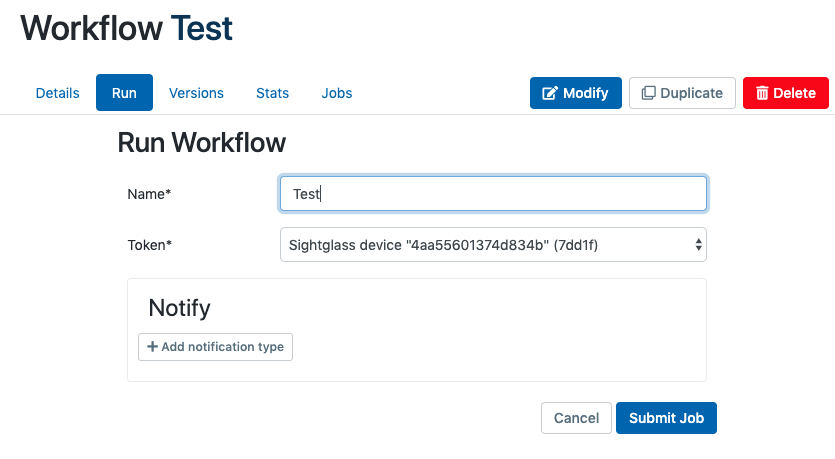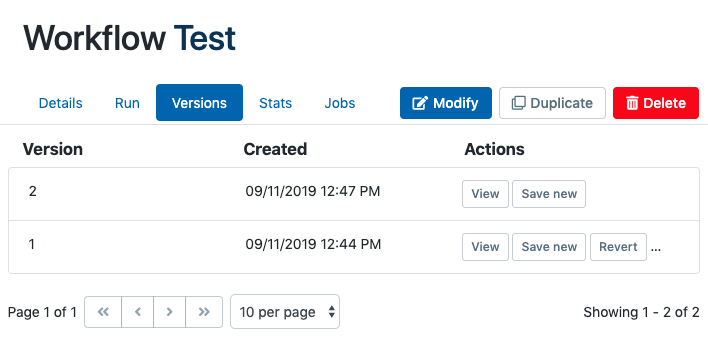Managing Workflows¶
Workflows orchestrate the components of the Aunsight platform, including other workflows. This powerful tool forms the backbone of data analytics projects, so organizations will make use of a large number of workflows. Creating and managing workflows requires a great deal of human effort, so to help Aunsight provides two different tools for managing workflows: The Workflows Workspace and the Workflow Builder. Because each of these interfaces interact with workflows on very different levels, each is discussed in a separate article. This article describes how to use the workflows workspace to manage workflows at the metadata level: creating workflows, editing their settings, and viewing information about their execution history. The next article will discuss the builder interface which allows users to actually step into a workflow graph and interactively edit its components to architect a workflow process.
The Workflows workspace¶
The Aunsight web interface provides a workflows workspace to users who have the AU-WORKFLOW:view-workflow permission available to them through a role or group they have in a given context.
To access this workspace, log in to the web interface and select the context you wish to work in through the context selector. From that context's dashboard, click the "Workflows" icon (![]() ) in the palette on the right.
) in the palette on the right.

The workflows workspace is a standard list-based view of workflows available in the present context. You can search (![]() ) and sort (
) and sort (![]() ) the list to find a workflow by clicking the appropriate icon at the top of the list. You can also create a new workflow by clicking the plus icon (
) the list to find a workflow by clicking the appropriate icon at the top of the list. You can also create a new workflow by clicking the plus icon (![]() ) or refresh (
) or refresh (![]() ) the list if changes made by another user are not appearing on the list.
) the list if changes made by another user are not appearing on the list.
Viewing Workflow Details¶
Clicking on the name of a workflow brings up that workflow into the main window where users can review details and perform actions on the metadata record for that workflow.

The web application interface displays information and tools in several tabs dedicated to group similar information and functions logically. Additionally, the workflow view has a group of action buttons that perform tasks relating to the workflow record as a whole.
Details tab¶
By default, Aunsight displays the "Details" tab where basic information about a workflow can be reviewed and edited.
-
The first section of the details tab displays basic metadata for the workflow, such as ID and description of the workflow, any tags it may have (Dev mode, solution, and custom tags), and the token associated with running the workflow. To edit these these descriptions, click the edit icon (
 ) in the upper right corner of this section to change the name, description, tagging information, and token settings.
) in the upper right corner of this section to change the name, description, tagging information, and token settings. -
The context section displays information about the ownership scope of the workflow. A workflow's primary owning contexts are displayed as well as any other contexts with which the workflow is currently being shared.
-
The activity history section displays a searchable and sortable log of workflow activity.
Run tab¶
The Run tab allows users to run an Aunsight workflow using run-time options specified via the interface.

When the desired options have been specified, click "Submit Job" to immediately run the workflow with these options.
Job Name¶
The name field allows users to specify a custom name for the workflow job. By default, Aunsight names jobs after the name of the workflow being run, but users can specify a custom name (for example, "3rd Quarter Sales Data Modeling" for the "Sales Data Modeling" workflow).
Job Token¶
The token field allows the user to specify a custom token. Normally, workflows will use the first valid token available to the creater, but it may be desired to specify a different token. For example, a user might want to specify a token that will expire at a given date so that users can run the workflow for only a given window of time.
Notifications¶
The notifications interface allows the user to request one or more notifications (usually emails) to be sent to specified members. For example, a user running a time-consuming workflow might want to run the process just before leaving in the evening. However, if the workflow fails at some time in the night, the user might want to know right away so they can take action well before they arrive back in the morning to make sure there is still plenty of time to debug and re-run the job before a deadline.
To specify a notification, click "Add notification type" which will bring up options for specifying the kind of notification to send.

- Method: Currently, only email notifications are supported.
- State: Send a notification if the workflow job fails or succeeds.
- Members: A drop-down list of members in the workflow's context to which you wish to send a message.
- Roles: Send a message to all members with a specified role in the workflow's context.
To add more than one notification, click the plus icon (![]() ) and repeat the process above until all desired notifications have been added.
) and repeat the process above until all desired notifications have been added.
Version tab¶
The versions tab provides a convenient interface to Aunsight's workflows version system. All changes to an Aunsight workflow graph made through the builder interface are saved before being overwritten. Every stage in this version history is assigned a number and date of revision. The versions tab displays this history as a chronological list.

The versions list displays the version number and date, followed by a number of action buttons for each version.
View¶
Displays the graph of this version in a pop-up window. This is usual for quickly comparing two versions to see differences between them. View will also display summary details about the differences between the components of this workflow and the previous one.
Save New¶
Creates a new workflow from this version. This option can be used to re-create a previous version of the workflow in parallel with the current version.
Revert¶
Reverts the workflow to an older version. This will prompt the user with a summary of the differences between the versions, and if the user chooses to continue, a copy of the previous version will be placed ahead of the previous most recent version.
Tip
Because the previous most recent version is still stored in the version history, users can undo accidental reversions by simply reverting to the version that was previously at the head of the workflow history.
Delete¶
Deletes this version of the workflow.
Warning
Deleting workflow versions is irreversible!
Note
When deleting versions, the version will be lost forever, but the version numbers of all subsequent versions will not be updated. This means users can still tell there was an intermediate version, even though it is no longer recoverable.
Stats tab¶
The Stats tab displays basic statistics on the run history of a workflow. Details about what percent of runs succeeded, failed, or were killed (stopped). This information can be useful for troubleshooting problems in a workflow's job history.
Jobs tab¶
The jobs tab provides a convenient way to monitor the state of jobs . The jobs tab provides a filtered view of data tracked in the jobs workspace so that users can easily monitor when and how a workflow was run, and what the results were. The jobs list shows the job ID, the name of the workflow, activity dates, state ("In Progress", "Succeeded", or "Failed"), and the name of the user who ran the workflow job (or the user who created the token used to run the workflow job).
Clicking the arrow icon (![]() ) on the job will leave the workflows workspace for the jobs workspace where you can review more details about that job's status.
) on the job will leave the workflows workspace for the jobs workspace where you can review more details about that job's status.
Workflow Actions¶
In addition to the features contained on the tabs of the workflows workspace, an action button group provides tools that affect the entire workflow.

Modify¶
The modify action button opens the current workflow in the Workflow Builder interface. The workflow builder allows users to view and interact with the workflow components, making this action one of the most important tools in the Workflows workspace!
Duplicate¶
The duplicate action button allows you to create a copy of the current workflow. This can be used, for example, to allow one workflow to serve as a template for new workflows, or to make a backup of an existing workflow under a different name.
Delete¶
The delete action button allows you to delete the workflow after confirming.

Warning
Workflow deletion is irreversible!